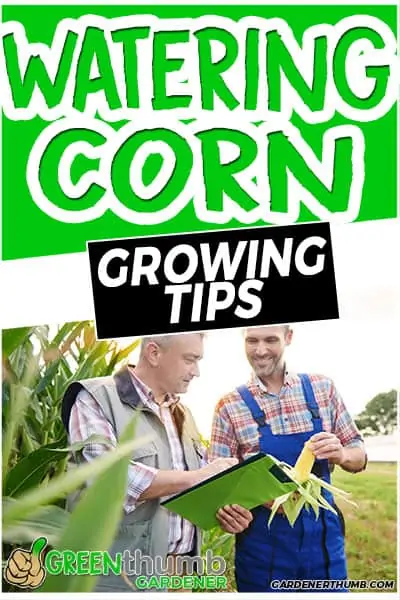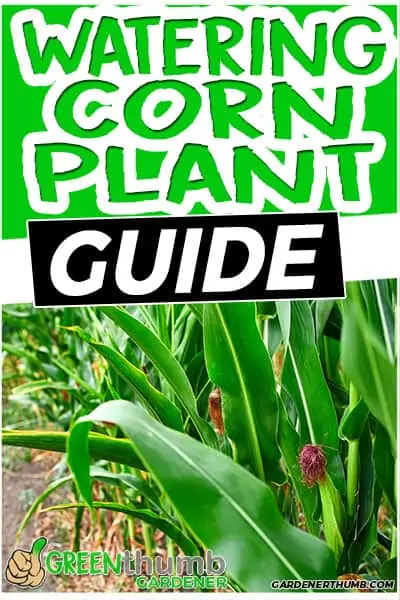How Much Water Does Corn Need
Last updated: 06/04/21
There are four main categories of corn in the United States: Dent corn, Sweet corn, Popcorn, and Flint corn. Aside from being tasty, corn is rich in fiber that aids in digestion.
It also provides essential nutrients like vitamin B and minerals like zinc, iron, magnesium, etc. But for your corn fields to produce those large ears full of delicious kernels, the corn needs fertile, well-drained soil and a constant supply of water to maintain soil moisture.
Green thumb Gardener occasionally links to product and/or services offered by vendors to assist you with all your gardening needs. Some of these may be affiliate links, meaning we earn a small commission if items are purchased.
Want to Download a Garden Hack Guide for FREE

Enter your email below and we will send you a guide to help you SAVE money in your garden.
How Often Do You Need To Water Corn?
During the planting season, the corn’s water requirements can vary. As much as possible, avoid skipping watering your corn patch.
Corn needs a lot of water to develop and thrive. You should make sure to soak it so that water can reach its deep roots. An under watered corn plant can drop its developing ears and will affect your corn yields.
Watering is essential, especially during the pollination period, since water stress can result in many missing kernels. On average, corn needs about 1 inch to 1 1/2 inches of water per week, especially when its stalks begin to tassel.
Use drip irrigation or a soaker hose and apply water at the surface of the soil. Do not spray above the plant since this will wash the pollen grain off the flower tops.
How Much Water Does Corn Need Per Day?
The young corn plant needs a constant supply of moisture to develop. For that to happen, adequate water needs to be absorbed by the soil to at least 4 to 30 inches depth range.
One of the critical stages of corn kernel formation is the tassel stage, and it is when the corn silks start to develop.
Corn silks are made up of 90 percent water, so they need a good rate of moisture to grow.
During the tassel stage, the corn crop needs around 1/4 inch per day of moisture. So you have to make sure there is regular corn watering.

The Corn Root System
How much water does corn need per day? To answer that, you have to understand the corn root system. Corn plant roots start to grow rapidly during the 4th-leaf stage.
Many factors, such as temperature, solar radiation, and soil moisture factors can affect plant development. When the weather is hot and dry, soil moisture is lost up to 6-inches deep because of soil water evaporation.
Corn roots have a deep root system, and on average, corn roots can grow from 2.75 inches during the vegetative stage to 60 inches during their reproductive growth stages.
The maximum depth will depend on how deep the water table is since root growth stops when they reach the water table.
Watering Daily Is Not Recommended
Since corn has a deep root system watering them daily is ineffective and impractical. When you water corn daily, it will only reach a few inches of soil and will not get to the deep roots. The excess water will evaporate.
Corn benefits from a deep soak to absorb the water and moisture from the soil. But you cannot soak your corn every day because it will be harmful to the plant. Watering and soaking daily encourages the growth of weeds and will affect corn’s development.
Water Corn Once a Week
The best way to provide the corn with enough moisture is to water it with at least 1 inch of water per week. But this has to be done in an extended period so that it is soaked in water.
Watering the soil surface will not reach the roots since they can go as deep as 60 inches . Your corn patch should be soaked with water weekly so that the moisture can get to the deeper portions of the ground and roots.
When Should You Water Corn?
The best time of day to water corn is in the morning when the temperature is lower. Water it early before the sun’s extreme heat evaporates the moisture from plant surfaces and moist soil.
Soaking is essential so you can have the appropriate soil water content. This will allow the corn’s deep roots to absorb water from the moist soil and help in corn formation.
Water is essential to reach optimal grain development. The lack of water will have adverse effects on the corn crop, so you should always be aware of the corn water requirements.
You have to make sure to maintain adequate soil moisture and mitigate the loss of water through evaporation.

When Does Corn Need The Most Water
Corn during the seedling stage uses little water. During this period, you can rely on stored soil moisture and natural precipitation. Unlike larger plants, young seedlings transpire less due to its smaller corn leaves surface.
During the vegetative growth stage, corn is least sensitive to water stress. When you have a limited supply of water or irrigation, you can reserve it for the next stage.
The early reproductive stages is the time when the demand and use of water are high especially during the tassel stage. During this crop growth stage, tasseling, silking, and pollination occur.
You should avoid water stress at these sensitive stages of development. You have to make sure there is an adequate supply of water during this very critical growth stages.
Avoid Water Stress
The deficiency of water primarily causes water stress. It is due to natural forces such as drought or human factors such as incorrect watering times.
If water stress happens for a prolonged period of time, it can negatively affect the stages of corn growth and development. As well as affect the corn’s physiology and decrease its productivity.
Therefore, it is necessary to avoid water stress and follow correct watering time as much as possible. Corn ears may not develop properly and reduce the quality of the corn kernels.
How Do I Know If The Corn Needs Water?
It’s essential to regularly water the corn plant and maintain soil moisture. Water the corn when you observed that the soil surface is already drying out.
The surface of the soil should always feel moist to the touch, not hard and dry. You have to water it in the morning to give time for water to be absorbed and avoid hot afternoon temperatures.
Thin weaker corn seedlings when at least 3 to 4 leaves appear and provide at least 8 inches distance between them. This will ensure enough space between your corn field crops to grow.

Further Reading
Watering Corn & Irrigation Tips
Proper irrigation management is essential. You should be aware of the seasonal water requirements because Improper irrigation will result in reductions in yield.
How to Use A Soaker Hose for Watering
Using a soaker hose is one of the easiest ways of watering your plant. Set up your soaker hose and water the corn plants for five minutes. Then wait around 2 hours so that water can penetrate the soil.
Different types of soils can absorb water at varying degrees, so it’s important to know the soil profile in your garden.
For example, it would take a shorter time to absorb moisture in sandy soil than in clay soil.
On average, you can moisten five inches deep of earth in five minutes or around 30 minutes to moisten 30 inches of soil. The best way to find out if the water has been absorbed is to dig a small hall to see how deep the water has penetrated.
How to Use A Sprinkler for Watering
Using a sprinkler is a convenient way of watering your corn plant. It has many advantages, especially in setting up the exact schedule of watering your corn patch.
Most sprinklers will need 1 hour of watering to supply 1 inch of water to the soil. So you only need 1 to 1 1/2 hour sprinkler once a week to ensure maximum yield potential and a bountiful corn harvest.
Drip Irrigation
Many farmers use drip irrigation because it can help increase yields, maximize profits and is more efficient. Drip uses 100% of the water directly to the plant unlike spray that can have a large amount of water loss due to evaporation.
Drip irrigation equipment is also readily available and easily installed. It has a 90% efficiency compared to other irrigation method such as sprinklers with a 50% to 70% efficiency.
Final Thoughts
Corn is one of the world’s most productive and dominant crops. It is used for various purposes, including food, animal feed, sweeteners, starch, and ethanol.
With proper care, irrigation, and know-how, you are assured of a constant supply of corn and a delicious harvest.
Related Questions
What is the best way to water sweet corn?
Sweet corn needs a good deal of water to thrive and, because it puts down relatively deep roots, requires watering techniques that soak the soil well below the surface.
What should I do to prevent weeds from growing on corn?
Corn can’t compete with weeds, so be sure to kill weeds thoroughly around the stalks for the first month of growth. You can also apply mulch to prevent weeds from sprouting.
What about the roots of corn?
After that, corn’s shallow roots will spread out as much as 1 foot from the stalk; be careful not to disturb these roots, because it’s easy to damage them.
What are the best ways to extend your harvest?
To extend your harvest, sow an early-maturing type every 2 weeks for 6 weeks, or plant early, mid-season, and late types at the same time.








